Just Another National Event
By Phil R. Elliott
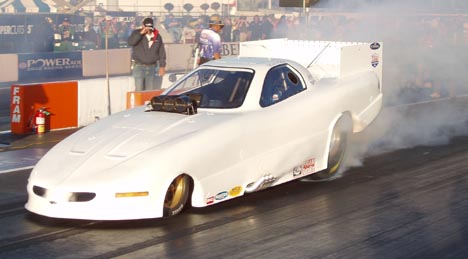 |
| Dale Pulde did a great job for a non entity. Flyin' Phil Photo |
Although the track is known as Infineon Raceway, it’ll always be simply Sears Point to me. Located in the very south end of this country’s largest wine producing region, the picturesque Napa Valley, the multi-use facility was named for a point of land that juts out into San Pablo Bay. To be even more accurate, it was named for the owner of that point of land, Franklin Sears, who settled on 600 acres south of Sonoma in 1851. Later, he partnered with his father-in-law to purchase some 15,000 acres, part of which is the present day racetrack.
Its first event came in late 1968 and the 720-acre site almost immediately became a financial loser. A broad spectrum of owners – from Hollywood moguls to real-estate investors came and went between times of near dormancy. This yo-yo continued until the early 1990s when Sears Point developed into arguably the world's busiest racing facility, with track activity scheduled an average of 340 days a year.
"Skip" Berg, a partner from 1981, took the reins totally in 1986 and named ex-NHRA Division Director Darwin Doll to manage. One of the immediate changes was to sign a contract with NHRA for a national event. Doll also
invited Les Richter and Bill France, Jr. to Sears Point
and negotiations began for bringing a NASCAR "Cup" race to the track. Just prior to signing the contract, Doll departed for an
opportunity to head Albuquerque
Int'l Raceway. Glen Long was hired as manager, the contract was signed, and the NASCAR era began at Sears Point. Marketing exec Steve Page was next to take the SP tiller and he oversaw about $4million in upgrades over a couple years.
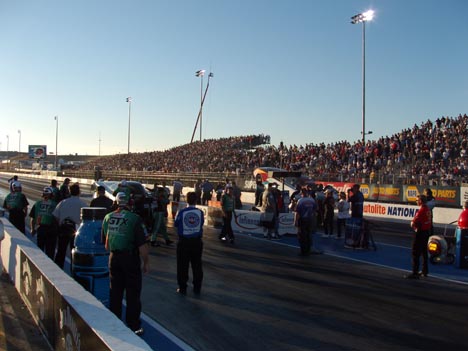 |
| Although you can easily see that the lights are on, the huge assembled multitude saw very little of what could be termed “night qualifying.” This is the last pair of FCs Friday, surrounded by their ground crews. Little did anyone know they would face off in the final two days later. Flyin’ Phil Photo |
The biggest leap came in 1996 when the good ol’ boys attracted a claimed 102,000 spectators for their circus, still a one-day attendance record for the track. Soon after, Bruton Smith, chairman of Speedway Motorsports, Inc., came a courtin’.
Since Smith’s purchase, the renamed Infineon Raceway has undergone a $50million renovation and modernization to both the road course and dragstrip. The job included moving a claimed nine and a half million cubic yards of dirt!
I went to Sears Point once in the very early 70s to a Division VII points race. It was an OK facility, seemingly a thousand mile from any populace. When I returned a whole bunch of times during my editorial tenure with Goodguys in the late 80s, it had been cleaned up a lot, many shops had been installed (the place is a race-oriented industrial park too), and Mike Yurick and Georgia Seipel were performing yeoman’s duties to keep the place going.
I went back several times, the most recent in 2001, to see the constant revisions and additions. Still, I was unready for what the place has become. I just attended the Fram-Autolite NHRA Nationals this past weekend, and was quite amazed at what I found.
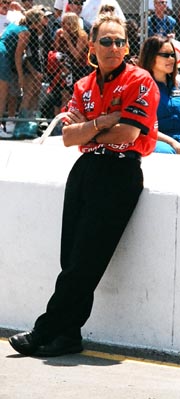 |
| Saturday, the third Pro session was set to begin at noon. A TAD got tangled in the net and it took quite some time to get things fixed up after which the alcohol session was completed. Kenny Bernstein, who reportedly had potential clients on the grounds, seemed rather unhappy about the scheduling SNAFU. Flyin' Phil Photo |
First, I’d like to say big thank yous to the Rounds Brothers, Brad and Chris, and to Buzz Baylis. Brad Rounds is the engineer at T&D Machine Products and races a bitchin’ SS/TB. He recently earned his first Super Stock win during the LODRS event at Infineon after about three seasons of trying. Buzz is my longtime friend and he invited me to stay in his beautiful home in Point Richmond, overlooking San Francisco Bay, and was my personal chauffer. I appreciate both favors very much.
Today, Sears Point/Infineon has been recreated into a world-class facility. There are permanent everythings. The pressroom is the best equipped on the NHRA tour. Buzz and I explored most of the facility and though the terrain is familiar, little if anything remains of what was there when I first saw it.
Like most Speedway Motorsports-owned tracks, a big emphasis is made to the family aspects. At Sears Point, there is a huge grandstand right at the finish line topped by a playground. When we visited, security checked us for alcohol, forbidden in the area, and dozens of children were taking advantage of the swings and slides available.
Back in the main spectator areas, there was all manner of foodstuffs. There were normal items such as burgers, hot dogs, sodas and beer. There were also pita pockets filled with steak, chicken or sausage, curly fries, frankfurters wrapped in small sourdough loaves, margaritas of many flavors sold out of little thatched booths, and even supposedly refreshing vodka/lemonade mixes. I suspect a few of those would indeed refresh.
I did not find calamari like I have at Laguna Seca, but still, it seemed to be a fun mix of stuff.
Hoofing it around Infineon takes quite an effort or a gas-powered golf cart. I did not have the latter. The elevation changes would cause Sir Edmund Hillary to break into a sweat. Thankfully, there were provided shuttles from the many parking sites, including from press parking to the media center. That saved me a few times.
Beyond the facility, I was impressed with a few of the performances.
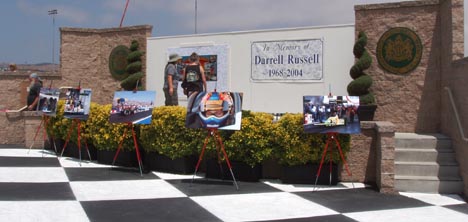 |
| The Infineon Winners Circle held a very nice tribute to a fallen hero, Darrell Russell. It was heavily visited although my photo doesn’t show that. To be honest, this photo was taken early Saturday morning. Flyin’ Phil Photo |
First, this was race two on the new 85% nitro maximum and TF was handed a new wing angle spec when the crews arrived. With these new parameters, several cars still ran 4.50s at over 320mph. Doug Kalitta was #1Q at 4.574/323 and went on to win the event over teammate David Grubnic. It was Doug’s fourth win at Infineon.
By the way, Tony Schumacher posted a track speed record of 325.85 mph in the Army dragster. He lost to Doug Kalitta in the semis and the two are now just 66 points apart
While Steve Chrisman made a field for the first time in my memory, Mike Strasburg was the only non-qualifier. The family owned B&J car fireballed twice during attempts.
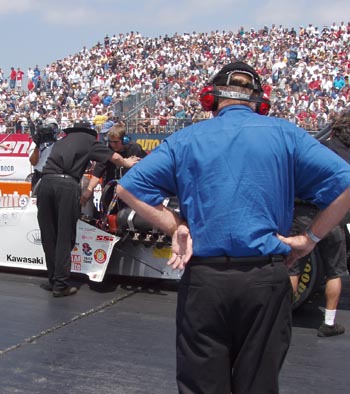 |
| I loved this scene. After skipping Q1 and oiling the track on Q2, Mitch King staged for another shot saturday afternoon. That's Ray Alley with the body English watching as Brent Fanning makes final adjustments. They made the field. Flyin' Phil Photo |
The biggest story in the funny car ranks was the return of Steve Plueger with veteran driver Dale Pulde aboard a stark white Firebird. I spoke to Dale Friday morning and he told me that NHRA was going to require him to make a couple singles to make sure he could still drive. As his familiar mustache twitched upwards in trying to hide a broad grin, I said a flippant, “as if…” and wished him luck.
Here sat a man that has been driving fuel funny cars since before his 16th birthday and who has won not only races in every sanction, but championships to boot. But rules are rules and since he was driving in his first event since the 1999 NHRA Winternationals, there was a necessary familiarization routine requirement. Both Steve and Dale were OK with that.
So in the Friday morning session, Pulde ran alone to a 6.24/225, which out of 19 attempters dropped him into 10th. Not a bad time trial. In the Friday night run, the car ran beside Bob Bode’s tire-smoking entry. The Plueger-owned machine went right down the lane to record a much-improved 5.66/249, a number that ended 17th after two runs.
The sheer fact that NHRA officials had allowed the Plueger/Pulde entry to run side-by-side in the proper qualified pairings gave the appearance that acceptance had been given.
On Saturday, with Bode on a reachable 5.465 bump, Pulde picked up again to a close 5.489/269, this time against Del Worsham’s tire-smoking 5.97/166.
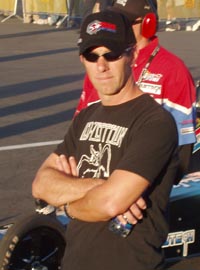 |
| Whtt Bazemore chose to make a Led Zeppelin statement during Friday qualifying. His team is trying hard to win the PowerAde championship. Flyin’ Phil Photo |
I need to add three things. First, I mention the times turned by these qualifying opponents to show that Dale Pulde was running competitive times every time he went down the track. Oh sure, there were some big numbers being turned in by the hitters. But to me and the thousands of assembled fans, Dale Pulde was performing his job well. Second, considering the 85% rule, everybody felt the previous speed minimum had been waved. Third, Plueger’s combo is way less than any other. While his fuel pump is on the large size, the engine has just a single 44-amp magneto, and the computer/timer box looks about the size of a Betty Boop lunch box.
In the final session, Terry Haddock singled and failed with a 5.61/205. Bob Gilbertson, under the very popular Jungle Jim (red) guise, pedaled several times but missed as well with his 5.85/215. In the other lane, Bode, still on the bump, had troubles of his own and coasted to an off pace 9.73.
Once again, Pulde staged alongside Worsham, the latter in the field a lowly 15th at 5.10/289. The two blazed off into the afternoon sun with the Checker-Shucks-Kragen pulling away until it struck its tires. Del lit the winlight with a hard fought 5.19/235, while Dale moved right alongside to record a 5.22/273.
Every run by Plueger/Pulde was better than the previous. There was never a waver, a wisp of smoke or a drop of oil. The two had more than accomplished their goals. They were in the big show once again.
For almost two hours.
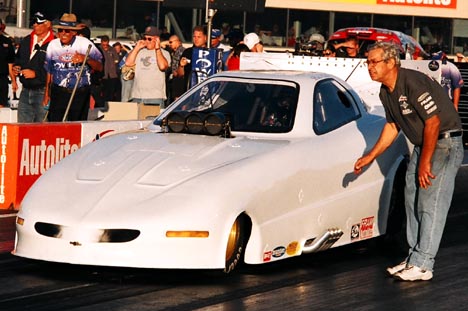 |
| Steve Plueger may need to revive the Moby Dick nomenclature -- the great white whale that may or may not have existed. Flyin' Phil Photo |
Nearly all of the qualified drivers were excited to have Dale Pulde back – after all, he is justifiably one of their heroes.
But, there was a scramble in the pits, with questions, finger pointing, allegations and various verbal threats. And, as the scene progressed, those that had OK’d the entry and the qualifying attempts backed down, wavered and bowed under the pressure.
The press was issued a statement to go along with a revised qualifying list:
“Dale Pulde, who qualified No. 16 in Funny Car, was disqualified following qualifying because it was discovered by race officials that his NHRA competition license had expired. Bob Bode, No. 17 qualifier in Funny Car, moves into the 16th position and will race top qualifier John Force in the first round of eliminations.”
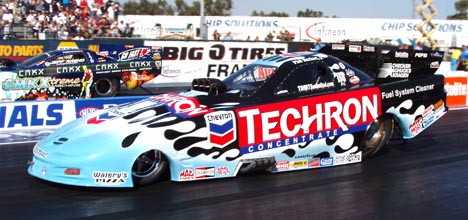 |
| Phil Burkhart’s Chevy wore a new paintjob to showoff a different product of his sponsor. Flyin’ Phil Photo |
The information was incorrect in fact because Dale Pulde’s license and medical information had always remained current. It even made NHRA look a little weak in the eyes of the media because checking a driver’s license is one of the initial parts of technical inspection. But in spirit, it was accurate because of that previously mentioned familiarization necessity. And, depending on who was talking, neither of the minimum speed numbers of 275mph and 280mph necessary to re-up a fuel license had been achieved. This is why I mentioned the numbers turned in by Pulde’s competitors.
I do not blame the pressroom for the mess at all. They were passing on information handed them. They issued another statement Sunday morning:
“Veteran Funny Car driver Dale Pulde, attending his first event since at Pomona, Calif., qualified in the 16th position. However, he was pulled from the starting lineup by NHRA officials at the end of qualifying when it was determined that he failed to record a performance necessary to update his NHRA competition license. Per NHRA rule, an inactive driver must update his or her NHRA competition license by clocking a time and speed within 10 percent of the current NHRA national record for that category. Non-qualifier Bob Bode was inserted into the No. 16 position for eliminations.”
Once, the 10% rule was strictly adhered to but the last few years it has evolved into the minimum speed (275mph usually) in both the fuel classes. This is due mainly to the fact that with both records over 330mph, it seemed more realistic that some rookie drivers wouldn’t reach a number within 10% during licensing. Also, the old rule about not being allowed to race on the same weekend as the licensing was completed has been waived due to track preparation. NHRA realizes how necessary it is to be on a national event prepared track surface to perform those types of numbers. That is not to say they’ll allow a brand new team to roll in and license during a national event. No way (Mostly, these licensing procedures take place during the Monday-after test sessions). But they will make provisions when absolutely necessary.
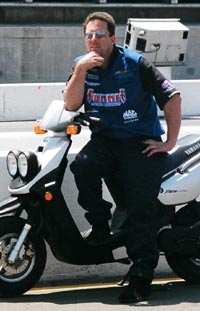 |
| Several times, Greg Anderson came out to check out the competition and the track surface. Flyin' Phil Photo |
Historically, there has only been one other similar situation in NHRA. It was during the 1978 Fallnationals. After two years of brilliant weather for the event, the third ('77) dawned with what everybody had expected for Seattle – rain. The event took two weekends to complete. Year four, it rained Thursday during tech and parking, and it rained all of Friday and Saturday. With heavy coats and hearts, the decision was made Sunday morning under dark, gloomy skies to get as much done as possible. It would be one-shot qualifying for everybody, and the race would get underway.
In FC, local Joe Clement had completed his licensing except for one thing. He’d made the six necessary runs and everything was signed off, except for making a “representative run.” That’s what it was called back then. That allowed for subpar track conditions and would be left to the disgression of the observers. In this case, it was Division VI Director, Frank Hall, himself a past Funny Car World Champion, who OK’d Joe to enter the Fallnationals and make a run on Friday morning to complete his license, then continue through the race if all went well. The weather threw everyone a major curve. With about thirty drivers trying for the 16 spots, on a cold, green track, there was action aplenty. And Joe Clement shuddered and stuttered with the best of them. His mid-seven second time earned him a mid-pack start. That is until a few of the sponsored racers compared notes.
I’ll add one last thing to this controversial little tale and then I will shut up. In all cases since what we call on the sidelines “the Paul Smith rule” was implemented (a qualified driver said he was broken to allow a non-qualified sponsored driver into the field), no alternates have been allowed into Professional fields. So in this case, Dale Pulde had to be completely wiped from the race as if he was never there.
So, both the 1977 Fallnationals and the 2004 Fram-Autolite NHRA Nationals now have something in common, a racer OK’d to make qualifying attempts and actually qualified, later to be wiped from the sheets never to show up as even an asterisk in Media Guides.
Interestingly, Dale Pulde’s license has been reinstated with little further discussion.
Two new rules will be in place. The NHRA Competition Committee has changed the minimums to 5.50 and 250mph. And, there will no longer be license runs allowed at NHRA national events. Period.
Oh the race?
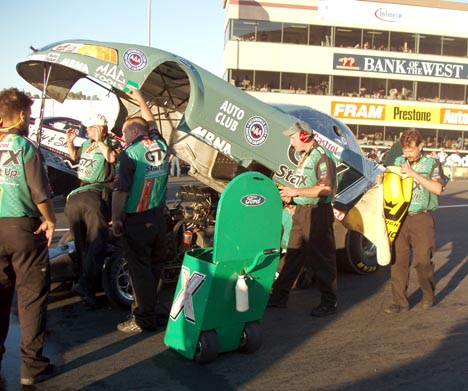 |
| John Force did everything at Infineon but win. One thing I noticed with nearly all of the nitro Pros was the use of these handy starter boxes. Because the tow vehicle heads for the other end to help get the car back quicker, the crew relies on a starter, bateries and a few tools that come out of a wheeled cart. Some are nicer than others, some are downright slick. Flyin' Phil Photo |
Team Force looked stout with all three of their entries in the top eight, with leader John on the pole (his 120th!) at 4.82/318. His ex-teammate and reining WC, Tony Pedregon was #2Q at 4.88/318. In R1, current teammate, Gary Densham, zoomed to a 4.82/321. In the semis, John forced a 4.85/322.42 out of his Castrol Mustang for a track record. And though he fouled away the final to Tim Wilkerson, Force left the Napa Valley with a points margin of 146 over Witt Bazemore.
 |
| Here is the near end to a couple eras. Troy Coughlin is retiring from Pro Stock and Mark Pawuk is losing Summit after many years of involvement. Of course, both mail-order giants will continue in dragracing. Flyin’ Phil Photo |
In Pro Stock, Greg Anderson became only the 5th driver in history to sweep the fabled western swing (Denver, Seattle, and Sonoma) and in the process tied his single-season Pro Stock record for victories at twelve. Many thought Anderson would falter somewhat when he debuted a new sponsor and car in the thin air at Denver, but the Summit Racing Pontiac Grand Am. It was only wishful thinking.
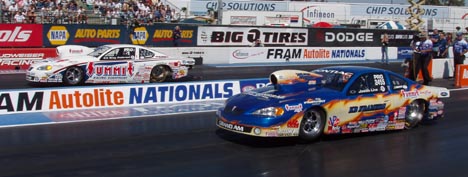 |
| Greg Anderson and Jason Line pretty well have the PS world right they want it. Flyin' Phil Photo |
At Infineon, his 6.693/206.01 led qualifying. The fact that this was his 28th pole seemed overshadowed because it was the second track in as many weeks where he’d dipped into the “sixties.” Teammate Jason Line posted a 206.42 for the track speed mark but he was holeshot in the semis by David Connolly. The other semi-finalist was Steve Johns. In the final, Anderson was even with Connolly at the start, then eased away from the Bill Jenkins-powered Bullet Motorsports Chevy Cavalier. It’s getting to be an old story.
Warren Johnson failed to qualify at Infineon for the second time in three years.
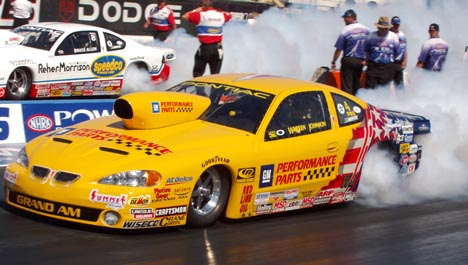 |
| Following a rather weak showing at Infineon, many wonder if it is time for The Professor to devote his full time to performance increases. It is just not right for DNQ to be associated with WJ. Flyin’ Phil Photo |
I want to make note of a really great thing about Pro Stock qualifying. I have written before about the one-shot format that comes when races have late evening sessions. That was not the case at this event. Even though there was a Friday night session, both PS cars and bikes rolled out in the late morning on Saturday to equal out any folk that flat missed on their set-ups. The conditions were somewhat better than they had been the previous night and it was one of the best sessions – performance wise – that I’ve ever seen.
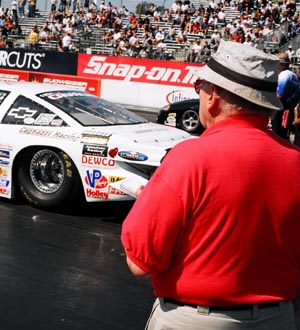 |
| Bill Jenkins has to be justifiably proud of how his PS engine program is going. |
It was the U.S. Army that dominated Pro Stock Bike. Angelle Savoie’s track record 7.084/188 led all qualifiers and she picked that up to 7.048 during eliminations. Army/Suzuki teammate Antron Brown recorded a heartbreaking -.001 redlite in the final to hand Angelle her 33rd career victory.
Since the weekend marked the 50th Anniversary of the San Francisco chapter of the Hells Angels, and plenty of members were present, Andrew Hines speed of 196.13 on his Screamin’ Eagle Harley-Davidson was extremely popular. It was the fastest speed in PSB history and a track record but was never backed up for a national number.
With news of Morgan Lucas taking over the TF ride of Joe Amato following the tragic loss of Darrell Russell, several TAD competitors seem happy. He was #3Q behind Duane Shields (5.23/272) and Darryl Hitchman (5.28/262) with 5.300/269 numbers. He stepped up to a 5.28/265 in R1, overshadowed by Shields (5.24/268) and Ashley Force (5.24/271). It was status quo in R2 for Lucas (5.285/264) and Shields (5.256/267), while Ms. Force recovered from tire shake to record a 5.35 at a whopping 275mph!
The young lady had a severe case of tire smoke in the semis while Shields cruised to a 5.287/266. Lucas took out the remaining blown entry, Chris Demke, 5.273/267 to 5.370/262 (Demke’s best of the weekend by far).
With such equal combatants, the final looked to be a toss up. But, Morgan Lucas grabbed a big lead and recorded a 5.279/266 for the win as Duane Shields slowed slightly again to a 5.294/266.
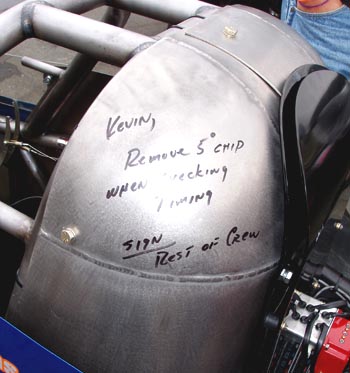 |
| Even in this world of seriousness, Steve Chrisman’s crew found time to take a shot at themselves. It was good to see them make the field. Flyin’ Phil Photo |
Considering Jay Payne’s 5.539/269 for #1Q, it seemed simple to hand him the trophy. Mark Woznichak’s amazing 5.597/257 was #2Q, followed by six cars in the 5.60s, and Bucky Austin’s 5.706.
Payne showed strength again in R1 with a 5.571 but he (and the rest of the world) was shocked in R2. Against Austin, both drivers were embarrassingly late. Then the two literally thundered to the quickest and fastest side-by-side alcohol FC race in history – Bucky’s 5.530/261.42 defeated Jay Payne’s 5.556/261.47. To make matters worse, the Valvoline-backed car had a late chute and skidded off the end into the sand. From all indications, Shelly Anderson-Payne, just two weeks from delivering offspring #2, was disgusted.
Marc White, who ran a career best 5.600/254 in R2, failed to return for the semis which allowed Doug Gordon to single. Dennis Taylor’s better light and 5.645/252 made the other race close, but Bucky’s 5.571/258 pulled out the win. The good news was that Austin’s run backed up a national record, the bad news was that the engine was hurt beyond repair.
After a thrash to replace the powerplant, Bucky Austin drove around Doug Gordon for the victory.
 |
| Former WC Dan Fletcher surprised himself on this single at the end of SS R2 by getting all four tires off the ground. I heard the engine rev up just as I hit the shutter release and this is the result. Note the rear tires are very round and show daylight underneath, Flyin’ Phil Photo |
|
Thanks for checking out the PhilZone portion of Draglist.com. If you have accolades, complaints, comments, questions, or if you want to share a story, please feel free to post it on the PhilZone Message Board.
Phil
|